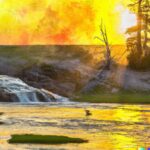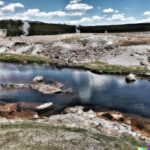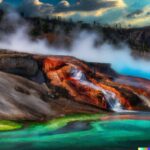Have you ever wondered what exactly a geyser is and how it is formed? In this article, we will explore the fascinating world of geysers, focusing on one of the most famous geysers in Yellowstone National Park – Old Faithful. From its discovery to its unique eruption patterns, we will delve into the history and science behind this natural wonder. So, grab a cup of tea and join us on a journey to learn more about what makes Old Faithful so special.
What is a Geyser?
Geysers are famous geological features found in Yellowstone National Park, known for their spectacular eruptions and unique natural wonders.
These remarkable geothermal formations are a result of the park’s underlying volcanic activity, creating a mesmerizing display of water and steam that captivates visitors from all over the world. Yellowstone is home to two main types of geysers: cone geysers, which are characterized by their tall cone-shaped formations, and fountain geysers, which erupt in a series of bursts reaching impressive heights. The iconic Old Faithful Geyser, perhaps the most famous of them all, draws crowds of spectators eager to witness its predictable eruptions that can reach heights of up to 184 feet, showcasing the incredible power and beauty of nature in action.
How are Geysers Formed?
Geysers are formed through a combination of geological processes, involving unique features, pressure build-up, and the intricate geology of the region.
The formation of geysers is a fascinating phenomenon driven by complex interactions within the Earth’s crust. Geological features such as underground chambers and fissures play a crucial role in allowing water to seep deep into the Earth. As this water gets heated by geothermal activity from the Earth’s core, pressure builds up within these sealed chambers. The underlying geology, including rock layers and tectonic movements, further influence geyser eruptions. The presence of a hotspot in the Earth’s mantle beneath a geyser field can create ideal conditions for the spectacular displays of hot water and steam that characterize these natural wonders.
History of Old Faithful
The history of Old Faithful, a famous geyser in Yellowstone National Park, dates back to its discovery and the initial documentation of its remarkable geological features.
Early explorers in the late 1800s were mesmerized by the regularity and power of Old Faithful’s eruptions, which led to its name due to the dependable nature of its activity. One of the first known written accounts of Old Faithful was recorded by the Washburn-Langford-Doane Expedition in 1870, solidifying its place as a significant natural wonder in Yellowstone.
Scientists like geologist Albert C. Peale played a crucial role in further documenting the geyser’s eruptions and studying its geological composition, contributing to a deeper understanding of the park’s unique thermal features.
Who Discovered Old Faithful?
Old Faithful was discovered by early tourists exploring the wonders of Yellowstone National Park in Wyoming, and it quickly became a landmark attraction for visitors.
They were mesmerized by the regularity and power with which Old Faithful would erupt, shooting water high into the air. This iconic geyser soon became a symbol of the park’s incredible geothermal features, drawing in travelers from far and wide to witness its awe-inspiring displays. Its predictability, erupting roughly every 60 to 90 minutes, allowed visitors to plan their experiences around its eruptions, creating a sense of anticipation and excitement among tourists exploring the unique landscapes of Yellowstone National Park.
When was Old Faithful First Documented?
Old Faithful’s eruptions were first documented through educational initiatives, with informational signs providing safety precautions and highlighting the environmental impact of the geyser’s activity.
These informational signs play a crucial role in educating visitors about the significance of preserving this natural wonder. By emphasizing safety measures and raising awareness about the fragile ecosystem surrounding the geyser, the park aims to foster a culture of responsible tourism.
Park rangers actively engage in conservation efforts to protect the biodiversity of the area. Educational programs offer insights into the geological processes that drive the geyser’s eruptions, further enhancing visitors’ understanding and appreciation of this unique natural phenomenon.
How Does Old Faithful Erupt?
Old Faithful erupts predictably at specific time intervals, showcasing impressive steam eruptions resulting from pressure build-up within its thermal system.
By studying the pressure dynamics and thermal activity underneath the geyser, scientists have found that the predictability of Old Faithful’s eruptions is a result of the unique way in which steam and water interact in the geyser’s underground chambers.
The time intervals between eruptions are a reflection of the steady accumulation of heat and pressure, creating a delicate balance that eventually leads to the spectacular display witnessed above ground.
The geyser’s eruption mechanism is a harmonious dance between nature’s forces, offering visitors a glimpse into the incredible power simmering beneath the earth’s surface.
What are the Factors that Affect Eruptions?
Several factors influence the eruptions of geysers like Old Faithful, including the temperature of boiling water, the height of the eruptions, and the underlying geological formations and rock layers.
The temperature of the boiling water within a geyser’s vent plays a crucial role in determining the frequency and intensity of eruptions. When the water reaches its boiling point, the resulting steam pressure builds up until it forces the water to erupt. The height reached during these eruptions can vary depending on factors like the volume of water expelled and pressure within the geyser. Geological formations and rock layers also have a significant impact, influencing the pathways through which water and steam flow within the geyser system.
How Often Does Old Faithful Erupt?
Old Faithful’s frequent eruptions make it a popular tourist destination, attracting crowds of visitors who gather on the boardwalk to witness the geyser’s majestic display under the guidance of park rangers.
The regularity of Old Faithful’s eruptions, occurring approximately every 60 to 110 minutes, allows visitors to plan their visits for an optimal viewing experience. Park rangers play a crucial role in managing the crowds that eagerly anticipate each eruption, ensuring that everyone stays safe while enjoying the natural spectacle.
The infrastructure surrounding the geyser, including well-maintained boardwalks and designated viewing areas, provides visitors with a comfortable and safe vantage point to admire the geothermal wonder. This careful organization by park management enhances the overall visitor experience and showcases the harmonious blend of nature and tourism at this iconic site.
How High Does Old Faithful Erupt?
Old Faithful reaches impressive heights during its eruptions, offering stunning views from designated viewing areas while emphasizing safety precautions, environmental impact mitigation, and conservation efforts.
The eruptions of Old Faithful can reach heights of up to 184 feet, creating a mesmerizing spectacle for visitors who gather at observation points specifically set up for optimal viewing. These viewing areas not only provide a safe vantage point for visitors to marvel at the geyser’s power but also serve to protect the fragile ecosystem surrounding it.
Comprehensive safety measures are enforced to ensure the well-being of guests, including barriers and warning signs to guide them away from hazardous areas. Ongoing preservation efforts focus on maintaining the geothermal ecosystem’s balance and reducing human impact, underscoring the importance of responsible tourism practices for future generations.”
What Makes Old Faithful Unique?
Old Faithful stands out for its distinct features, including the surrounding geyser basin, the visitor center offering educational insights, and the iconic thermal cone that characterizes the geyser.
Located in Yellowstone National Park, Old Faithful’s setting within the Upper Geyser Basin adds to its allure, with a backdrop of bubbling geothermal activity. The visitor center nearby provides a wealth of information on geology, thermal dynamics, and the unique ecosystem that thrives in this thermal wonderland. The striking thermal cone, formed by mineral deposits over years of eruptions, is a defining visual feature, showcasing the power and beauty of nature’s geological formations.
Temperature and Chemical Composition of Old Faithful’s Water
The temperature and chemical composition of Old Faithful’s water play a crucial role in its geothermal activity, making it an iconic geyser known for its predictable eruptions and natural wonders.
The scalding water within Old Faithful, heated by the Earth’s core, builds up pressure below the surface, creating the breathtaking eruptions that captivate visitors from around the world. This geyser’s consistency in erupting every 90 minutes to two hours has solidified its reputation as a must-see natural phenomenon in Yellowstone National Park. The unique mix of minerals and gases in Old Faithful’s water contributes to the stunning display of steam and water that shoots high into the sky, leaving spectators in awe of nature’s power and beauty.
Other Geysers in the Upper Geyser Basin
Apart from Old Faithful, the Upper Geyser Basin is home to impressive geysers like Steamboat Geyser, Castle Geyser, and Riverside Geyser, known for their unique characteristics and the presence of bacterial thermophiles.
-
Steamboat Geyser, the world’s tallest active geyser, erupts with immense power, sometimes reaching heights of over 300 feet, captivating visitors with its spectacular displays.
-
Castle Geyser, characterized by its distinctive cone formation resembling a castle turret, erupts at regular intervals, demonstrating the thermal activity beneath Yellowstone’s surface.
-
Riverside Geyser, situated along the Firehole River, delights spectators with its graceful eruptions that often create beautiful rainbows amidst the surrounding thermal features.
The colorful bacterial thermophiles that thrive in these geysers provide a glimpse into the unique ecosystem supported by the extreme heat and mineral-rich waters of the hydrothermal system.
Visiting Old Faithful
Planning a visit to Old Faithful involves considering the best time to witness its eruptions, explore nearby attractions like the Grand Prismatic Spring, and marvel at the diverse hydrothermal features in the area.
Timing is crucial for observing the awe-inspiring geyser eruptions at Old Faithful; early mornings or late afternoons are ideal to avoid crowds and capture beautiful shots. After experiencing the magnificence of Old Faithful, don’t miss the chance to venture towards the Grand Prismatic Spring, renowned for its vibrant colors and breathtaking beauty. Exploring the various hydrothermal features in the region provides a deeper understanding of the unique geological processes at play, making your visit both educational and awe-inspiring.
Best Time to Visit Old Faithful
The best time to visit Old Faithful is often during the quieter hours of the early morning or late afternoon, allowing visitors to experience the geyser’s eruptions with fewer crowds and explore nearby facilities like the Old Faithful Inn, Visitor Education Center, and live views through the Old Faithful Webcam.
During these optimal visiting times, guests can immerse themselves in the serenity of the natural surroundings while witnessing the spectacular display of nature’s power. The Old Faithful Inn offers a charming retreat for visitors to relax and appreciate the historic architecture, while the Visitor Education Center provides valuable insights into the geology and wildlife of the area. For those unable to be present in person, the Old Faithful Webcam offers a convenient way to observe the geyser’s eruptions from anywhere in the world, adding an interactive element to the experience.
Guided Tours and Programs at Old Faithful
Visitors to Old Faithful can enrich their experience through guided tours and educational programs that showcase nearby geysers, provide insights into geothermal monitoring efforts, and explore phenomena like hydrothermal explosions, thermal disturbances, and the community of geyser gazers.
These educational opportunities at Old Faithful offer a deep dive into the world of geothermal research, allowing participants to witness first-hand the intriguing processes that shape these unique landscapes. The guided tours not only educate visitors about the science behind geyser activity but also foster a sense of community among geyser enthusiasts. The programs provide a platform for individuals to engage with experts in the field, gaining a comprehensive understanding of the geological wonders and environmental significance of geysers and hot springs.
Last Updated on February 8, 2024 by Jon Waraas – Originally Posted: February 7, 2024

I’m Jon Waraas, and I’ve been navigating the online world since 2006. By day, I’m the proud owner of some eCommerce gems, and by night, I’m the voice behind the adventures on Waraas.Com.
My heart, however, belongs to the wild beauty of Yellowstone National Park. I’ve got a collection of websites dedicated to sharing the wonders of this natural masterpiece. Oh, and did I mention? I’m currently building my own cabin inside the ghost town of Gilmore, Idaho – a cabin with tales to tell!
When I’m not immersed in the digital realm, you’ll find me lacing up my boots for a good hike or setting up camp under the star-studded sky.




